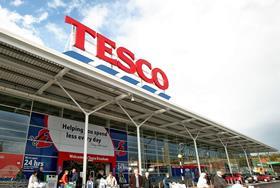
Tesco has endured a further fall in profits.
Underlying profits for the first half of its financial year were £354 million, 55 per cent down on the same period last year.
Its pre-tax profit was £74m, compared with a loss of £19m for the same period a year ago.
UK like-for-like sales were down 1.1 per cent in the second quarter, an improvement from the first quarter's fall of 1.5 per cent. International sales were up 1 per cent.
In February, Tesco reported the worst results in its history, with a record statutory pre-tax loss of £6.4bn for the year to the end of February 2015.
Chief executive Dave Lewis said: 'In the UK, we continue to improve all aspects of our offer for customers, resulting in volume growth which is allowing us to create a virtuous circle of investment.
'Our transformation programme in Europe has accelerated growth and reduced operating expenses, and in Asia, we have gained market share in challenging economic conditions.'
The supermarket is still under a criminal investigation by the Serious Fraud Office (SFO) after it admitted overstating its profits by £263m nearly a year ago.
Tesco’s Q2 results, David Gray, retail analyst at Planet Retail, said: “As expected, the numbers this morning indicate further signs of stabilisation at Tesco’s domestic unit, with like-for-like declines narrowing on those reported at Q1. There were also encouraging signs on volumes at Tesco, indicating this is a volume-led recovery.
“These figures have firmly cemented the split in the UK mid-market into two camps - Tesco/Sainsbury’s showing signs of recovery and Asda/Morrisons being the laggards. Considering Tesco was in the throes of the accounting scandal just 12 months ago, being in the former camp is an achievement in itself.
“Despite positive numbers in CEE, problems are persisting in Asia where like-for-likes remained flat in Q2 - an improvement, yes, but not stellar growth. Although Tesco’s Chairman has recently reaffirmed its commitment to the geographies in which it now trades, long-term disposals could still be on the cards considering the relative weakness in the company’s balance sheet and the lack of a dunnhumby sale.
“With Korea already culled, Malaysia is the obvious next market at risk with limited growth potential. However, it is profitable and well-established and so could command a decent price. In CEE, markets like Poland would generate the largest windfall considering its size relative to neighbouring markets and the presence of a string of international operators that could be would-be buyers. Most of these aforementioned markets look safe – for now at least.”



